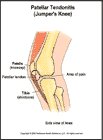
Patellar Tendonitis (Jumper's Knee)
What is patellar tendonitis?
Patellar tendonitis, also called jumper's knee, is inflammation in the band of tissue (the patellar tendon) that connects the kneecap (patella) to the shinbone (tibia).
How does it occur?
The most common activity causing patellar tendonitis is too much jumping. Other repeated activities such as running, walking, or bicycling may lead to patellar tendonitis. All of these activities put repeated stress on the patellar tendon, causing it to be inflamed.
Patellar tendonitis can also happen to people who have problems with the way their hips, legs, knees, or feet are aligned. This alignment problem can result from having wide hips, being knock-kneed, or having feet with arches that collapse when you walk or run, a condition called over-pronation.
The patellar tendon may sometimes tear completely, or rupture, during strenuous activity.
What are the symptoms?
Symptoms may include:
- pain and tenderness around the patellar tendon
- swelling in your knee joint or swelling where the patellar tendon attaches to the shinbone
- pain with jumping, running, or walking, especially downhill or downstairs
- pain with bending or straightening the leg
- tenderness behind the kneecap.
If your patellar tendon is ruptured, usually you will have sudden severe pain and you will be unable to straighten your leg or walk.
How is it diagnosed?
Your health care provider will examine your knee to see if you have tenderness at the patellar tendon. He or she will also have you run, jump, or squat to see if this causes pain. Your feet will be examined to see if you have a problem with over-pronation. Your provider may order x-rays or an MRI of your knee.
How is it treated?
Treatment may include:
- applying ice to your knee for 20 to 30 minutes every 3 to 4 hours for 2 to 3 days or until the pain and swelling go away
- taking anti-inflammatory medication or a pain medication prescribed by your health care provider
- wearing a band across the patellar tendon, called an infrapatellar strap, or a special knee brace; the strap or brace will support your patellar tendon, preventing it from becoming overused or more painful
- wearing custom-made arch supports called orthotics if you have a problem with over-pronation.
If your patellar tendon is ruptured, you will need surgery right away to repair it. If you have a lot of scar tissue in or around your tendon causing pain you may need surgery to remove it.
You will be given rehabilitation exercises to help you return to your sport or activity. While you are recovering from your injury you will need to change your sport or activity to one that does not make your condition worse. For example, you may need to swim instead of play basketball.
When can I return to my sport or activity?
The goal of rehabilitation is to return you to your sport or activity as soon as is safely possible. If you return too soon you may worsen your injury, which could lead to permanent damage. Everyone recovers from injury at a different rate. Return to your sport or activity will be determined by how soon your knee recovers, not by how many days or weeks it has been since your injury occurred. In general, the longer you have symptoms before you start treatment, the longer it will take to get better.
You may safely return to your sport or activity when, starting from the top of the list and progressing to the end, each of the following is true:
- Your injured knee can be fully straightened and bent without pain.
- Your knee and leg have regained normal strength compared to the uninjured knee and leg.
- Your knee is not swollen.
- You are able to jog straight ahead without limping.
- You are able to sprint straight ahead without limping.
- You are able to do 45-degree cuts.
- You are able to do 90-degree cuts.
- You are able to do 20-yard figure-of-eight runs.
- You are able to do 10-yard figure-of-eight runs.
- You are able to jump on both legs without pain and jump on the injured leg without pain.
How can I prevent patellar tendonitis?
Patellar tendonitis is usually caused by overuse during activities such as jumping or running or biking uphill. It can best be prevented by having strong thigh muscles.
The following may also help prevent injury:
- When you exercise, wear shoes that fit properly and are right for the activity.
- Gently stretch before and after exercising.

